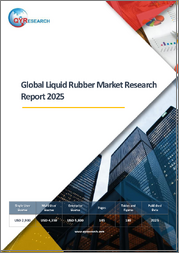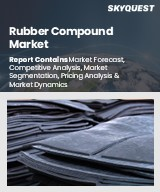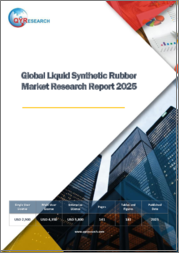
|
시장보고서
상품코드
1703427
세계의 부틸 고무 시장 : 산업 규모, 점유율, 동향, 기회 및 예측 - 판매채널별, 최종 용도별, 지역별, 경쟁별(2020-2030년)Butyl Rubber Market - Global Industry Size, Share, Trends, Opportunity, and Forecast, Segmented By Sales Channel, By End Use, By Region and Competition, 2020-2030F |
||||||
부틸 고무 세계 시장 규모는 2024년에 40억 7,050만 달러로 평가되었습니다. 2030년까지 51억 7,490만 달러에 달할 것으로 예상되며, 예측 기간 동안 연평균 성장률(CAGR)은 6.07%를 보일 것으로 예측됩니다.
이러한 꾸준한 성장은 주로 자동차, 제약, 산업 분야 수요 증가에 기인합니다.
| 시장 개요 | |
|---|---|
| 예측 기간 | 2026-2030년 |
| 시장 규모 : 2024년 | 40억 7,050만 달러 |
| 시장 규모 : 2030년 | 51억 7,490만 달러 |
| CAGR : 2025-2030년 | 6.07% |
| 급성장 부문 | 직접 판매 |
| 최대 시장 | 아시아태평양 |
부틸 고무는 뛰어난 공기 불투과성, 내열성, 화학적 안정성으로 유명한 합성 엘라스토머로 타이어 제조, 의약품 마개, 접착제, 보호 도료 등에 폭넓게 활용되고 있습니다. 자동차 부문은 여전히 가장 큰 최종 사용자이며, 특히 타이어 내부 라이너와 튜브에서 가장 큰 수요처입니다. 가스 투과성이 낮고 유연성이 높아 타이어의 내구성을 높이고 공기 누출을 최소화하여 연비 향상에 기여합니다.
전기자동차(EV) 시장의 확대는 제조업체들이 에너지 사용을 최적화하기 위해 경량화 및 고성능 소재를 찾는 경향이 높아지면서 수요를 더욱 가속화시키고 있습니다.
좋은 시장 환경에도 불구하고 몇 가지 과제가 남아 있습니다. 원자재 가격 변동, 엄격한 환경 규제, 복잡한 생산 공정 등이 주요 관심사입니다. 부틸 고무 생산은 석유에서 추출한 이소부틸렌과 이소프렌에 의존하기 때문에 업계는 원유 가격과 석유화학 공급망 변동에 매우 민감합니다. 원유 가격의 불안정성은 생산 비용과 수익성에 직접적인 영향을 미치기 때문에 생산자는 비용 경쟁력을 유지해야 한다는 압박을 받게 됩니다.
주요 시장 성장 촉진요인
제약 산업의 성장
주요 시장 과제
원자재 가격 변동
주요 시장 동향
기술 발전과 제품 혁신
목차
제1장 제품 개요
제2장 조사 방법
제3장 주요 요약
제4장 세계의 부틸 고무 시장에 대한 COVID-19의 영향
- 세계의 부틸 고무 시장 전망
- 시장 규모와 예측
- 금액별
- 시장 점유율과 예측
- 판매채널별(직접 판매, 간접 판매)
- 최종 용도별(타이어 및 튜브, 의약품용 캡, 건설, 접착제 및 실란트, 기타)
- 지역별
- 기업별(2024년)
- 시장 맵
제5장 북미의 부틸 고무 시장 전망
- 시장 규모와 예측
- 금액별
- 시장 점유율과 예측
- 판매채널별
- 최종 용도별
- 국가별
- 북미 : 국가별 분석
- 미국
- 멕시코
- 캐나다
제6장 유럽의 부틸 고무 시장 전망
- 시장 규모와 예측
- 시장 점유율과 예측
- 유럽 : 국가별 분석
- 프랑스
- 독일
- 영국
- 이탈리아
- 스페인
제7장 아시아태평양의 부틸 고무 시장 전망
- 시장 규모와 예측
- 시장 점유율과 예측
- 아시아태평양 : 국가별 분석
- 중국
- 인도
- 한국
- 일본
- 호주
제8장 남미의 부틸 고무 시장 전망
- 시장 규모와 예측
- 시장 점유율과 예측
- 남미 : 국가별 분석
- 브라질
- 아르헨티나
- 콜롬비아
제9장 중동 및 아프리카의 부틸 고무 시장 전망
- 시장 규모와 예측
- 시장 점유율과 예측
- 중동 및 아프리카 : 국가별 분석
- 남아프리카공화국
- 사우디아라비아
- 아랍에미리트(UAE)
제10장 시장 역학
- 성장 촉진요인
- 과제
제11장 시장 동향과 발전
- 인수합병(M&A)
- 제품 출시
- 최근 동향
제12장 세계의 부틸 고무 시장 : SWOT 분석
제13장 Porter의 Five Forces 분석
- 업계내 경쟁
- 신규 참여 가능성
- 공급업체의 힘
- 고객의 힘
- 대체품의 위협
제14장 경쟁 구도
- Reliance Sibur Elastomers Private Limited
- Arlanxeo(Saudi Amarco)
- Japan Butyl Co. Ltd
- Sinopec(Beijing Yanshan Company)
- Exxon Mobil
- Zhejiang Cenway New Materials Co., Ltd
- Shandong Chambroad Petrochemicals Co., Ltd
- Formosa Synthetic Rubber Corporation
- Lanxess
- Tolyattikauchuk(SIBUR)
제15장 전략적 제안
제16장 회사 소개 및 면책조항
LSH 25.04.29Global butyl rubber market was valued at USD 4,070.50 million in 2024 and is projected to reach USD 5,174.90 million by 2030, growing at a compound annual growth rate (CAGR) of 6.07% during the forecast period. This steady growth is primarily driven by rising demand across the automotive, pharmaceutical, and industrial sectors.
| Market Overview | |
|---|---|
| Forecast Period | 2026-2030 |
| Market Size 2024 | USD 4070.50 Million |
| Market Size 2030 | USD 5174.90 Million |
| CAGR 2025-2030 | 6.07% |
| Fastest Growing Segment | Direct Sales |
| Largest Market | Asia-Pacific |
Butyl rubber, a synthetic elastomer known for its exceptional air impermeability, thermal resistance, and chemical stability, is extensively utilized in tire manufacturing, pharmaceutical stoppers, adhesives, and protective coatings. The automotive sector remains the largest end-user, especially in tire inner liners and tubes. Its low gas permeability and high flexibility enhance tire durability, minimize air leakage, and contribute to improved fuel efficiency.
The expanding electric vehicle (EV) market is further accelerating demand, as manufacturers increasingly seek lightweight, high-performance materials to optimize energy usage.
Despite favorable market conditions, several challenges persist. The volatility of raw material prices, stringent environmental regulations, and complex production processes are key concerns. Butyl rubber production relies on isobutylene and isoprene, both petroleum-derived, making the industry highly sensitive to fluctuations in crude oil prices and petrochemical supply chains. Price instability in crude oil directly affects manufacturing costs and profitability, placing pressure on producers to maintain cost competitiveness.
Key Market Drivers
Growth in the Pharmaceutical Industry
The global pharmaceutical market is expected to generate USD 1.21 trillion in revenue by 2025. The United States, with its advanced healthcare infrastructure and robust R&D capabilities, continues to lead pharmaceutical innovation.
Pharmaceutical applications rely heavily on butyl rubber-based closures such as stoppers, vial seals, and syringe components due to their excellent airtightness and chemical inertness. These properties are essential for maintaining the sterility and integrity of injectable drugs and vaccines. The growing prevalence of chronic illnesses-including diabetes, cardiovascular diseases, and cancer-has driven increased production of injectable medications, further supporting demand for butyl rubber components in pharmaceutical packaging.
Key Market Challenges
Raw Material Price Volatility
One of the primary challenges facing the butyl rubber industry is the fluctuation in raw material costs. Isobutylene and isoprene-critical feedstocks in butyl rubber production-are derived from petroleum and are directly affected by global crude oil price movements.
Geopolitical instability, OPEC policies, and shifts in global supply and demand dynamics contribute to crude oil price volatility. Consequently, the cost and availability of these key inputs vary, impacting production costs and ultimately pricing structures for manufacturers and end-users alike. This price instability can disrupt profitability and complicate long-term strategic planning for producers.
Key Market Trends
Technological Advancements and Product Innovation
Significant advancements in product development-particularly the emergence of halobutyl rubber, including chlorobutyl and bromobutyl variants-are reshaping the market. These materials exhibit enhanced air retention, heat resistance, and compatibility with other elastomers, making them highly suitable for advanced tire designs and pharmaceutical applications.
LANXESS, the world's second-largest producer of butyl rubber, has completed a major expansion of its Sarnia, Ontario facility, increasing its global butyl and halobutyl rubber production capacity by 42% to 265,000 tonnes annually-a 25% rise from previous levels. This follows a prior 10% expansion at its Zwijndrecht plant in Belgium. The company's continued investment underscores its commitment to meeting rising global demand.
Key Market Players
- Reliance Sibur Elastomers Private Limited
- Arlanxeo (Saudi Amarco)
- Japan Butyl Co. Ltd
- Sinopec (Beijing Yanshan Company)
- Exxon Mobil
- Zhejiang Cenway New Materials Co., Ltd
- Shandong Chambroad Petrochemicals Co., Ltd
- Formosa Synthetic Rubber Corporation
- Lanxess
- Tolyattikauchuk (SIBUR)
Report Scope
In this report, the Global Butyl Rubber Market has been segmented into the following categories, in addition to the industry trends which have also been detailed below:
Butyl Rubber Market, By Sales Channel:
- Direct Sales
- Indirect Sales
Butyl Rubber Market, By End Use:
- Tyre and Inner Tube
- Pharmaceutical Closures
- Construction
- Adhesives & Sealants
- Others
Butyl Rubber Market, By Region:
- North America
- United States
- Canada
- Mexico
- Europe
- France
- United Kingdom
- Italy
- Germany
- Spain
- Asia Pacific
- China
- India
- Japan
- Australia
- South Korea
- South America
- Brazil
- Argentina
- Colombia
- Middle East & Africa
- South Africa
- Saudi Arabia
- UAE
Competitive Landscape
Company Profiles: Detailed analysis of the major companies present in the Global Butyl Rubber Market.
Available Customizations:
Global Butyl Rubber Market report with the given market data, TechSci Research offers customizations according to a company's specific needs. The following customization options are available for the report:
Company Information
- Detailed analysis and profiling of additional market players (up to five).
Table of Contents
1. Product Overview
- 1.1. Market Definition
- 1.2. Scope of the Market
- 1.2.1. Markets Covered
- 1.2.2. Years Considered for Study
- 1.2.3. Key Market Segmentations
2. Research Methodology
- 2.1. Objective of the Study
- 2.2. Baseline Methodology
- 2.3. Key Industry Partners
- 2.4. Major Association and Secondary Sources
- 2.5. Forecasting Methodology
- 2.6. Data Triangulation & Validation
- 2.7. Assumptions and Limitations
3. Executive Summary
- 3.1. Overview of the Market
- 3.2. Overview of Key Market Segmentations
- 3.3. Overview of Key Market Players
- 3.4. Overview of Key Regions/Countries
- 3.5. Overview of Market Drivers, Challenges, and Trends
4. Impact of COVID-19 on Global Butyl Rubber Market
- 4.1. Global Butyl Rubber Market Outlook
- 4.2. Market Size & Forecast
- 4.2.1. By Value
- 4.3. Market Share & Forecast
- 4.3.1. By Sales Channel (Direct Sales, Indirect Sales)
- 4.3.2. By End Use (Tyre and Inner Tube, Pharmaceutical Closures, Construction, Adhesives & Sealants, Others)
- 4.3.3. By Region
- 4.3.4. By Company (2024)
- 4.4. Market Map
5. North America Butyl Rubber Market Outlook
- 5.1. Market Size & Forecast
- 5.1.1. By Value
- 5.2. Market Share & Forecast
- 5.2.1. By Sales Channel
- 5.2.2. By End Use
- 5.2.3. By Country
- 5.3. North America: Country Analysis
- 5.3.1. United States Butyl Rubber Market Outlook
- 5.3.1.1. Market Size & Forecast
- 5.3.1.1.1. By Value
- 5.3.1.2. Market Share & Forecast
- 5.3.1.2.1. By Sales Channel
- 5.3.1.2.2. By End Use
- 5.3.1.1. Market Size & Forecast
- 5.3.2. Mexico Butyl Rubber Market Outlook
- 5.3.2.1. Market Size & Forecast
- 5.3.2.1.1. By Value
- 5.3.2.2. Market Share & Forecast
- 5.3.2.2.1. By Sales Channel
- 5.3.2.2.2. By End Use
- 5.3.2.1. Market Size & Forecast
- 5.3.3. Canada Butyl Rubber Market Outlook
- 5.3.3.1. Market Size & Forecast
- 5.3.3.1.1. By Value
- 5.3.3.2. Market Share & Forecast
- 5.3.3.2.1. By Sales Channel
- 5.3.3.2.2. By End Use
- 5.3.3.1. Market Size & Forecast
- 5.3.1. United States Butyl Rubber Market Outlook
6. Europe Butyl Rubber Market Outlook
- 6.1. Market Size & Forecast
- 6.1.1. By Value
- 6.2. Market Share & Forecast
- 6.2.1. By Sales Channel
- 6.2.2. By End Use
- 6.2.3. By Country
- 6.3. Europe: Country Analysis
- 6.3.1. France Butyl Rubber Market Outlook
- 6.3.1.1. Market Size & Forecast
- 6.3.1.1.1. By Value
- 6.3.1.2. Market Share & Forecast
- 6.3.1.2.1. By Sales Channel
- 6.3.1.2.2. By End Use
- 6.3.1.1. Market Size & Forecast
- 6.3.2. Germany Butyl Rubber Market Outlook
- 6.3.2.1. Market Size & Forecast
- 6.3.2.1.1. By Value
- 6.3.2.2. Market Share & Forecast
- 6.3.2.2.1. By Sales Channel
- 6.3.2.2.2. By End Use
- 6.3.2.1. Market Size & Forecast
- 6.3.3. United Kingdom Butyl Rubber Market Outlook
- 6.3.3.1. Market Size & Forecast
- 6.3.3.1.1. By Value
- 6.3.3.2. Market Share & Forecast
- 6.3.3.2.1. By Sales Channel
- 6.3.3.2.2. By End Use
- 6.3.3.1. Market Size & Forecast
- 6.3.4. Italy Butyl Rubber Market Outlook
- 6.3.4.1. Market Size & Forecast
- 6.3.4.1.1. By Value
- 6.3.4.2. Market Share & Forecast
- 6.3.4.2.1. By Sales Channel
- 6.3.4.2.2. By End Use
- 6.3.4.1. Market Size & Forecast
- 6.3.5. Spain Butyl Rubber Market Outlook
- 6.3.5.1. Market Size & Forecast
- 6.3.5.1.1. By Value
- 6.3.5.2. Market Share & Forecast
- 6.3.5.2.1. By Sales Channel
- 6.3.5.2.2. By End Use
- 6.3.5.1. Market Size & Forecast
- 6.3.1. France Butyl Rubber Market Outlook
7. Asia Pacific Butyl Rubber Market Outlook
- 7.1. Market Size & Forecast
- 7.1.1. By Value
- 7.2. Market Share & Forecast
- 7.2.1. By Sales Channel
- 7.2.2. By End Use
- 7.2.3. By Country
- 7.3. Asia Pacific: Country Analysis
- 7.3.1. China Butyl Rubber Market Outlook
- 7.3.1.1. Market Size & Forecast
- 7.3.1.1.1. By Value
- 7.3.1.2. Market Share & Forecast
- 7.3.1.2.1. By Sales Channel
- 7.3.1.2.2. By End Use
- 7.3.1.1. Market Size & Forecast
- 7.3.2. India Butyl Rubber Market Outlook
- 7.3.2.1. Market Size & Forecast
- 7.3.2.1.1. By Value
- 7.3.2.2. Market Share & Forecast
- 7.3.2.2.1. By Sales Channel
- 7.3.2.2.2. By End Use
- 7.3.2.1. Market Size & Forecast
- 7.3.3. South Korea Butyl Rubber Market Outlook
- 7.3.3.1. Market Size & Forecast
- 7.3.3.1.1. By Value
- 7.3.3.2. Market Share & Forecast
- 7.3.3.2.1. By Sales Channel
- 7.3.3.2.2. By End Use
- 7.3.3.1. Market Size & Forecast
- 7.3.4. Japan Butyl Rubber Market Outlook
- 7.3.4.1. Market Size & Forecast
- 7.3.4.1.1. By Value
- 7.3.4.2. Market Share & Forecast
- 7.3.4.2.1. By Sales Channel
- 7.3.4.2.2. By End Use
- 7.3.4.1. Market Size & Forecast
- 7.3.5. Australia Butyl Rubber Market Outlook
- 7.3.5.1. Market Size & Forecast
- 7.3.5.1.1. By Value
- 7.3.5.2. Market Share & Forecast
- 7.3.5.2.1. By Sales Channel
- 7.3.5.2.2. By End Use
- 7.3.5.1. Market Size & Forecast
- 7.3.1. China Butyl Rubber Market Outlook
8. South America Butyl Rubber Market Outlook
- 8.1. Market Size & Forecast
- 8.1.1. By Value
- 8.2. Market Share & Forecast
- 8.2.1. By Sales Channel
- 8.2.2. By End Use
- 8.2.3. By Country
- 8.3. South America: Country Analysis
- 8.3.1. Brazil Butyl Rubber Market Outlook
- 8.3.1.1. Market Size & Forecast
- 8.3.1.1.1. By Value
- 8.3.1.2. Market Share & Forecast
- 8.3.1.2.1. By Sales Channel
- 8.3.1.2.2. By End Use
- 8.3.1.1. Market Size & Forecast
- 8.3.2. Argentina Butyl Rubber Market Outlook
- 8.3.2.1. Market Size & Forecast
- 8.3.2.1.1. By Value
- 8.3.2.2. Market Share & Forecast
- 8.3.2.2.1. By Sales Channel
- 8.3.2.2.2. By End Use
- 8.3.2.1. Market Size & Forecast
- 8.3.3. Colombia Butyl Rubber Market Outlook
- 8.3.3.1. Market Size & Forecast
- 8.3.3.1.1. By Value
- 8.3.3.2. Market Share & Forecast
- 8.3.3.2.1. By Sales Channel
- 8.3.3.2.2. By End Use
- 8.3.3.1. Market Size & Forecast
- 8.3.1. Brazil Butyl Rubber Market Outlook
9. Middle East and Africa Butyl Rubber Market Outlook
- 9.1. Market Size & Forecast
- 9.1.1. By Value
- 9.2. Market Share & Forecast
- 9.2.1. By Sales Channel
- 9.2.2. By End Use
- 9.2.3. By Country
- 9.3. MEA: Country Analysis
- 9.3.1. South Africa Butyl Rubber Market Outlook
- 9.3.1.1. Market Size & Forecast
- 9.3.1.1.1. By Value
- 9.3.1.2. Market Share & Forecast
- 9.3.1.2.1. By Sales Channel
- 9.3.1.2.2. By End Use
- 9.3.1.1. Market Size & Forecast
- 9.3.2. Saudi Arabia Butyl Rubber Market Outlook
- 9.3.2.1. Market Size & Forecast
- 9.3.2.1.1. By Value
- 9.3.2.2. Market Share & Forecast
- 9.3.2.2.1. By Sales Channel
- 9.3.2.2.2. By End Use
- 9.3.2.1. Market Size & Forecast
- 9.3.3. UAE Butyl Rubber Market Outlook
- 9.3.3.1. Market Size & Forecast
- 9.3.3.1.1. By Value
- 9.3.3.2. Market Share & Forecast
- 9.3.3.2.1. By Sales Channel
- 9.3.3.2.2. By End Use
- 9.3.3.1. Market Size & Forecast
- 9.3.1. South Africa Butyl Rubber Market Outlook
10. Market Dynamics
- 10.1. Drivers
- 10.2. Challenges
11. Market Trends & Developments
- 11.1. Merger & Acquisition (If Any)
- 11.2. Product Launches (If Any)
- 11.3. Recent Developments
12. Global Butyl Rubber Market: SWOT Analysis
13. Porters Five Forces Analysis
- 13.1. Competition in the Industry
- 13.2. Potential of New Entrants
- 13.3. Power of Suppliers
- 13.4. Power of Customers
- 13.5. Threat of Substitute Products
14. Competitive Landscape
- 14.1. Reliance Sibur Elastomers Private Limited
- 14.1.1. Business Overview
- 14.1.2. Company Snapshot
- 14.1.3. Products & Services
- 14.1.4. Financials (As Reported)
- 14.1.5. Recent Developments
- 14.1.6. Key Personnel Details
- 14.1.7. SWOT Analysis
- 14.2. Arlanxeo (Saudi Amarco)
- 14.3. Japan Butyl Co. Ltd
- 14.4. Sinopec (Beijing Yanshan Company)
- 14.5. Exxon Mobil
- 14.6. Zhejiang Cenway New Materials Co., Ltd
- 14.7. Shandong Chambroad Petrochemicals Co., Ltd
- 14.8. Formosa Synthetic Rubber Corporation
- 14.9. Lanxess
- 14.10. Tolyattikauchuk (SIBUR)
15. Strategic Recommendations
16. About Us & Disclaimer
(주말 및 공휴일 제외)


















